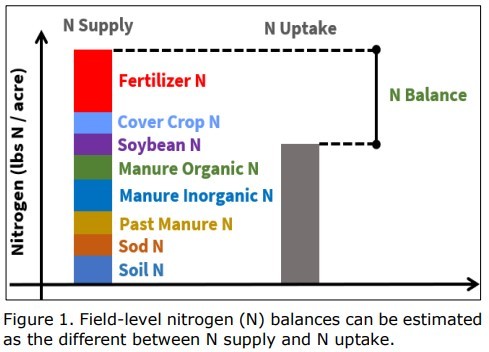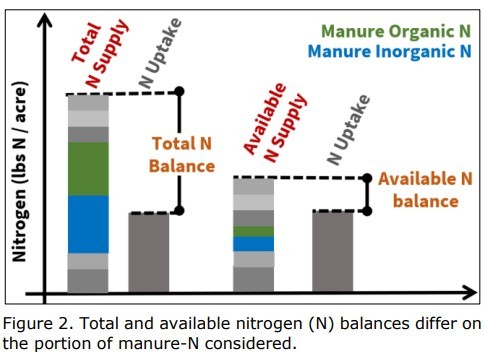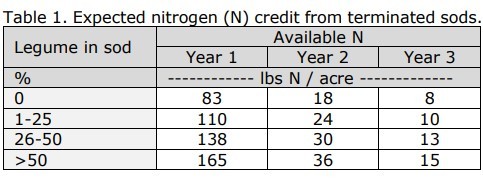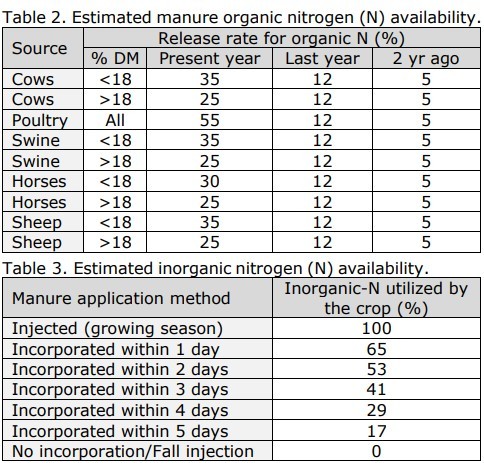Field Nitrogen Balances for Corn Silage
Introduction
A field nutrient balance is an end-of-season evaluation tool defined as the difference between nutrients accessible for crop uptake (nutrient supply), and nutrients removed with forage harvest (nutrient uptake). A large positive balance (excess) signals inefficient use of inputs (including fertilizer and manure), elevated risk of nutrient loss to the environment and/or accumulation in soil over time. Tracking field balances, especially for nitrogen (Figure 1) can help inform if a change in field nutrient management can be considered without negatively impacting crop yield or quality. This factsheet explains the steps involved in deriving field nitrogen (N) balances for corn silage.

Available versus total N balances
The way manure is managed (application method and timing) impacts the amount of plant-available N we can expect from a specific manure application. More informed decisions can be made when both the total amount of N and N availability are evaluated. Thus, it is important to derive two types of field N balances: (1) available N balance; and (2) total N balance. The total N balance of a given crop year considers the total amount of N applied with manure, independent of timing (e.g. fall or spring) or method of application (surface applied versus incorporated or injected). The available N balance takes into account only the portion of N in the manure that is considered plant available in the year for which the balance is derived (Figure 2).

Determining N balances
There are three main steps in determining total and available N balances for a corn silage field.
Step 1: Estimate N uptake per acre
Corn varieties can differ in the amount of N per ton of silage. If reliable forage sample results are available for the field, use the crude protein content listed on the forage report and the following equation to derive the amount of N (lbs N) in a ton of silage (at 35% dry matter):
N per ton=(%CP/100/6.25)*2000*0.35
If field specific data are not available, assume 8.6 lbs N/ton of corn silage (at 35% DM) for short-season hybrids (≤95 days-tomaturity [DTM]) and 8.2 lbs N/ton of corn silage (35% DM) for long-season hybrids (≥96 DTM). If hybrid relative maturity information is not
available, an average of 8.4 lbs N/ton of corn silage (35% DM) can be used.
Once the total amount of N per ton of silage is determined, multiply this number and the yield per acre (also at 35% DM) to obtain N
uptake per acre for the field.
N uptake per acre=yield (ton/acre)*N/ton
Step 2: Estimate N supplyTo determine N supply, sum the contributions of the following N sources.
NSoil
Soil organic matter can supply 40 to 80 lbs of N/acre annually. The soil's N supplying capacity (Nsoil in lbs N/acre) is a function of soil type and tile drainage. Estimates of soil N supply can be found in Appendix Table 2 of the Nitrogen Guidelines for Field Crops in New York.
NSod
Alfalfa, grass, and mixed alfalfa/grass stands will release N into the soil once they are terminated prior to seeding of corn. The amount
of N expected from a terminated sod varies depending on the percentage of legume in the stand and the number of years that have passed since termination of the stand (Table 1).

NSoybeans
Corn that follows soybean in a rotation will require less external N than continuous corn. A representative estimate of soybean N credits for corn for N balance assessments is 30 lbs N/acre.
NCoverCrop
Cover crops can also supply N to the crop that follows. The amount of biomass, its N content, and its C:N ratio (maturity) can greatly
influence N dynamics in the soil after termination. A representative estimate of cover crop N credits for corn for use in field N balances
is 30 lbs N/acre. This assumes spring termination of a fall-planted, timely seeded, overwintering cereal grain cover crop such as cereal rye, winter wheat, or triticale.
NManureInorganic, NManureOrganic, NResidualManure
When estimating N supply for total N balances, total organic and inorganic N contributions from manure can be determined by multiplying fieldlevel manure application rates with total N content as listed on the manure analysis. For available N balances, N contributions need to consider when and how manure was applied using Tables 2 and 3. Residual N credits are derived from Table 2 as well.

NFertilizer
Nitrogen contributions from fertilizer are determined by multiplying the application rate and the N content of the material.
Step 3: Estimate available and total N balances
The final field N balances are derived by subtracting N uptake from N supply.
In Summary
Field N balances are end-of-season evaluations to help optimize field N management. Deriving field balances requires assessment of N supply and N uptake using easily obtainable records.
Additional Resources
• Cornell NMSP Agronomy Fact Sheet Series.
http://nmsp.cals.cornell.edu/guidelines/factsheets.html.
Field Nitrogen Balances for Corn Silage (pdf; 178KB)
Upcoming Events
Crops, Cows & Critters - Southwest New York Dairy, Livestock & Field Crops Newsletter Sponsorship
December 19, 2025
Our two forms of publications feature research-based and timely information from our four specialists, listed to the right, along with local event notifications and Cornell University outreach. This information is provided to participants who range from dairy, livestock, and field crops producers to agricultural suppliers and consultants.
Weekly Email Update: Shared with 625+ households who have signed up with our program.
Monthly Paper Mailer: To reach our stakeholders and farmers who lack internet access, we send out a monthly mailer where your company's logo and contact information would be featured with a mailing list of 330+ households.
If you sponsor our weekly and monthly publications you reach approximately 955 households.
Visit our website to view our newsletters!
2025 Cornell Food Beverage & Animal Feed Manufacturer Survey
December 19, 2025
Industry and Educational Advocates for New York State's Food, Beverage, and Animal Feed Manufacturing industries:
As you know, NYS has a diverse food and beverage manufacturing industry, in both the types of industries that exist and the wide distribution of firms by scale. Many manufacturing firms have strong backward linkages to agricultural production sectors in the state that support both farm-level and downstream food industry firms and consumers. In collaboration with the New York State Department of Agriculture and Markets, a team from Cornell University's Charles H. Dyson School of Applied Economics and Management has recently rolled out the 2025 New York State Food, Beverage, and Animal Feed Manufacturer Survey. The industry will benefit from an updated assessment of the industry that informs private and public investments and opportunities to support firm growth and improved profitability.
Cornell Organic Field Crops & Dairy Conference
March 6, 2026
Waterloo, NY
Farmers, researchers, educators, and agricultural service providers from across the Northeast are invited to the 2026 Cornell Organic Field Crops & Dairy Conference, held Friday, March 6, 2026, from 8:00 a.m. to 4:30 p.m. at the Lux Hotel & Conference Center in Waterloo, N.Y.
Co-hosted by New York Soil Health and Cornell CALS, the annual conference brings together leaders in organic grain, dairy, and livestock systems to share practical tools, new research, and farmer-tested strategies to support resilient and profitable organic production.
Announcements
No announcements at this time.





